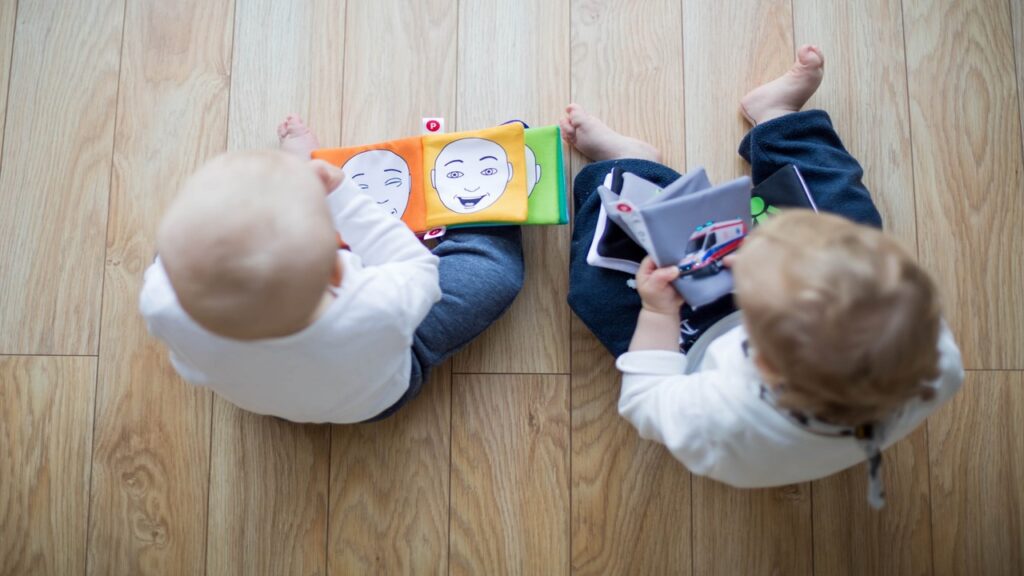Do you feel that your toddler’s naptime is a tiresome task for you? Do you feel worried about that time, as it seems a Herculean task to complete? Toddler naps are sometimes too long, sometimes too short, and there is no naptime. Worst-case scenario: no nap at all. While it may appear frightening at first look, recognizing the underlying causes and devising appropriate solutions can help to avoid this predicament. Here we have described 5 ways to get your toddler to take a nap.
Table of Contents
What are the Reasons that Toddlers Fight Naptime?
There could be multiple reasons behind this, but some of the primary reasons are:
1. They are overly exhausted,
2. They still have stored energy in them
3. They do not want to miss the actions going on in their surroundings.
Let us have a look at all these issues one by one.
1. They are overly exhausted
Exhaustion is the primary reason behind a struggling naptime, and playing and engaging in physical activity for several hours makes a toddler fatigued during naptime. It also happens because their sleep cycle gets disturbed after extensive play and fatigue. They take naps at inconvenient times, and most of the time, they sleep for 10-15 minutes. Therefore, the importance of naptime after physical activity increases manifold to reduce their tiredness.
2. They still have pent-up energy in them
Often it happens that kids feel overstimulated. They have an extensive burst of Adrenaline that kicks them to behave to their maximum potential. They want to continue the fun and all the happenings. Due to this sudden kick of Adrenaline, they find it difficult to sleep during their routine time. It could also happen due to an exciting activity during the sleeping time like tummy tickling or after having a piece of chocolate.
3. They do not want to miss the actions going on in their surroundings
Sometimes toddlers do not want to miss the activity they were having before their nap time, and they feel that they will devoid themselves of all the action happening in their absence after sleep. To avoid sacrificing their activity time for naptime, they prefer to play.
What should be the Duration of Your Toddler’s Naptime?
The typical duration of naptime for a toddler is 1-2 hours. It is not a good sign if toddlers nap longer than this, as it will result in a later bedtime. If a child naps less than he does, it leads to a cranky attitude, as their sleep is not complete. Taking naps for longer than this and sleeping at night is a gold mine for parents, but if a child takes proper naps for a more extended period than this, then parents are ecstatic.
Is There Any Nap Schedule for a Toddler?
The schedule of toddlers’ naptime varies according to a child’s age, but some of the common ones are:
| Age Slots | Naptime | Number of Naps |
| Newborns (0 to 3 months) | 14 to 17 hours | 4-6 naps a day |
| Babies (4 to 12 months) | 12 to 16 hours | 2-4 naps a day |
| Toddlers (1 to 2 years) | 11 to 14 hours | 1-3 naps a day |
| Preschoolers (3 to 5 years) | 10 to 13 hours | Most children stop taking naps at this age. However, some continue to do so. |
| School Going Children (6 to 12 years) | 9 to 12 hours | Naps shift tonight, sleep |
5 Ways to Get Your Toddler Take a Nap
Here are five simple yet effective activities to help your toddler take a soothing nap without any fuss.

1. Set a Consistent Routine Everyday:
Consistent routine builds a pattern. The body’s biological clock sets accordingly, and it helps to fall toddlers asleep easier. Children’s development relies heavily on a proper routine. It will also benefit your child, providing more productivity, stability, and focus. Setting a bedtime is the best approach. Set a proper sleeping and waking time, and setting a pattern will ensure proper naptimes without any fuss.
You must provide your child with a quality-napping environment in addition to putting them to sleep. Watching television or driving will disrupt their sleep pattern if they take a short nap. It will, however, help them feel more relaxed and confident about sleeping in their bed or crib if they nap there. They will develop an affiliation with the place and prefer to rest there safe and sound. Consistency in sleeping space will provide a longer and more sustainable sleep cycle.

2. Burn off the Stored Energy before Naptime:
Toddlers are little bundles of energy and hyperactivity. This hyperactive energy does not allow them to settle and sleep easily. If you want your toddler to take a nap at a set routine, you need to burn off their extra energy until their bedtime. The solution is to cut down the screen time and set more playing activities. Pool time, backyard activities, or indoor exercises such as pretend play. The more time they spend in playing, running, taking swings, and driving tricycles, the more energy they will release. Mental activities and games also come in handy here. Some examples are puzzles, painting, craftwork, Legos, blocks, and kinetic sand. All of these activities under supervision can engage your child for a long time physically and mentally.

3. Feed Them Snack or Lunch before Naptime while Avoiding Sugary Items:
An empty tummy could also be a reason behind an agitated toddler. A child does not feel like sleeping if their appetite is not satiated. Therefore, take their naptime closer to their lunchtime or mid-morning snack. Feed them something which would help them to sleep peacefully.
Sugary treats at naptime, on the other hand, work as a stimulant. Sugary things hinder your child’s sleeping pattern. These are extra stimulants, which will keep him wired up, and he will not be able to release his pent-up energy. We cannot wholly zone it out, but keeping it to a minimum will ensure a better sleeping routine.

4. Start with a Pre-Nap Soothing Routine:
The transition from an action-packed pre-nap time to a quiet and serene sleeping time is not easy, requiring a mellow-down approach. For this purpose, you need to set a pre-nap calming routine. It is a mini version of the usual bedtime routine. You gradually prepare your toddler for naptime by making him relaxed and calm. Some people use it for bathing time, some parents use this time for massage, and some use it for reading or singing. It brings familiarity and acknowledgment to the sleep process, and once being habitual, your child will look forward to it.
Sometimes, siblings could also be why the toddler does not want to take a nap. Make the older sibling a part of the pre-nap routine in this situation. This addition will aid with your toddler’s relaxation.
5. Don’t Rush it and Keep Your Child in Confidence:
Setting the routine will take time, and this time can be given to toddlers. This step can take up to two weeks, depending on how long the timetable takes to set up. Napping is crucial to set the routine, and they need to understand it.
Toddlers have a profound urge for independence and control. They need to be taken into account while setting their routine. Although they cannot speak correctly, they understand everything. You can communicate your expectations about their sleep time and where they have to sleep—explaining the set routine and how it will help them build trust in them. It allows them to accept what they are going to do during naptime.

Why and When do Kids Stop taking Naps?
Although there is no specific period to identify the end of naptime, it is probably somewhere between 3-4 years. The identification sign could be the resistance that comes every time with naptime. If it gets tiring, it’s time for them to stop napping.
As the child gets older, they feel more independent and in power. When they start cribbing about naptime time, they are becoming assertive. It is their Showtime. Words can play a magical role here. You can replace naptime with quiet time and allow the child to spend the time quietly in their room. The effect would be pleasing, as they would not feel under pressure of the nagging naptime. This time can become more meaningful with some purposeful toys and games, especially for this purpose.
However, do not stop this process so quickly. Many toddlers do it for the sake of avoiding it. Instead of having a sleep-deprived child, spend a long time on their naps. Sometimes it is successful, and sometimes it is not.
Conclusions:
If nothing from the abovementioned tips works for you, you can also consult your child’s pediatrician. Nevertheless, one thing is vital to understand. Every toddler is unique, with different abilities and potentials. You must have patience like a saint, as this phase will need some time to function. We also have some tips for waking up toddler from a nap or sleep to smooth the process as well.
Enjoy every tiny moment with your child! And leave us a comment if you have other tips!
About Me
Hi, there. I am Lin. Together with my husband and two kids, we live in the beautiful Netherlands in Europe. I am dedicated to self-development, creating quality time for the whole family, and fully supporting kids with their potentials with all I have learned from engineering, MBA, and 10+ years of working experience in the energy sector.



2 Comments
Comments are closed.